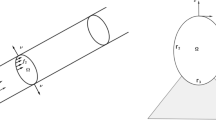Abstract
Dual extremum principles are established in this paper for the variational boundary-value problem of elasto-perfect plasticity with large deformation. There exists a duality gap between the primal and dual variational problems. Our application to nonlinear limit analysis yields a pair of dual bounding theorems for the safety factor, when the gap has the right sign. It is proved that both the upper and lower bounds directly depend on the properties of the dual gap function.
Similar content being viewed by others
References
Duvaut G. and Lions J. L.: Inequalities in Mechanics and Physics, Springer, New York, 1976.
Kohn R. and Temam R.: Dual spaces of stresses and strains, with applications to Hencky plasticity, Appl. Math. Optim. 10 (1983), 1–35.
Panagiotopoulos P. D.: Inequality Problems in Mechanics and Applications, Birkhäuser, Basle, 1985.
Temam R.: Problèmes mathématiques en plasticité, Bordas, Paris, 1983.
Temam R. and Strang G.: Duality and relaxation in the variational problems of plasticity, J. Mécanique 19 (1980), 493–527.
Temam R. and Strang G.: Functions of bounded deformation, Arch. Rational Mech. Anal. 75 (1980), 7–21.
Gao Yang: On the complementary principles for elastoplastic systems and panpenalty finite element methods, Ph D thesis, Tsinghua University, 1985.
Gao Yang and Hwang Keh-chih: On the complementary energy variational principle for Hencky plasticity, in Chien Wei-zang (ed.), Proc. Int. Conf. Nonlinear Mechanics, Shanghai, China, 1985, Science Press, Beijing, pp. 489–494.
Gao, Yang and Hwang, Keh-chih: Complementary energy principles for elasto-perfect plasticity, Sci. Sinica Series A 11 (1987).
Gao Yang: On the complementary bounding theorems of limit analysis, Internat. J. Solids and Structures 24 (1988), 545–556.
Gao Yang: Panpenalty finite element programming for limit analysis, Computers and Structures 28 (1988), 749–755.
Onat E. T. and Haythornthwaite R. M.: The load-carrying capacity of circular plates at large deflection, J. Appl. Mech. 23 (1956), 49–55.
Onat E. T.: The influence of geometry changes on the load-deformation behavior of plastic solids, Plasticity, proc. 2nd U.S. Naval Struc. Mech., Pergamon Press, London, 1960, pp. 225–238.
Sawczuk, A.: Large deflections of rigid-plastic plates, Proc. 11th Congress of Appl. Mech., Munchen, 1964.
Gao Yang and Strang Gilbert: Geometric nonlinearity: Potential energy, complementary energy, and the gap function, Quart. Appl. Math. 47 (1989), 487–504.
Ekeland I. and Temam R.: Convex Analysis and Variational Problems, North-Holland, Amsterdam, 1976.
Author information
Authors and Affiliations
Additional information
This research was supported by Army Research Office grant DAAL 03-86-K 0171 and National Science Foundation grant DMS-87-03313.
Rights and permissions
About this article
Cite this article
Gao, Y., Strang, G. Dual extremum principles in finite deformation elastoplastic analysis. Acta Appl Math 17, 257–267 (1989). https://doi.org/10.1007/BF00047073
Received:
Accepted:
Issue Date:
DOI: https://doi.org/10.1007/BF00047073




